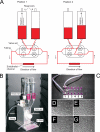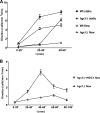Hgc1 mediates dynamic Candida albicans-endothelium adhesion events during circulation
- PMID: 20023069
- PMCID: PMC2823009
- DOI: 10.1128/EC.00307-09
Hgc1 mediates dynamic Candida albicans-endothelium adhesion events during circulation
Abstract
Common iatrogenic procedures can result in translocation of the human pathogenic fungus Candida albicans from mucosal surfaces to the bloodstream. Subsequent disseminated candidiasis and infection of deep-seated organs may occur if the fungus is not eliminated by blood cells. In these cases, fungal cells adhere to the endothelial cells of blood vessels, penetrate through endothelial layers, and invade deeper tissue. In this scenario, endothelial adhesion events must occur during circulation under conditions of physiological blood pressure. To investigate the fungal and host factors which contribute to this essential step of disseminated candidiasis, we have developed an in vitro circulatory C. albicans-endothelium interaction model. We demonstrate that both C. albicans yeast and hyphae can adhere under flow at a pressure similar to capillary blood pressure. Serum factors significantly enhanced the adhesion potential of viable but not killed C. albicans cells to endothelial cells. During circulation, C. albicans cells produced hyphae and the adhesion potential first increased, then decreased with time. We provide evidence that a specific temporal event in the yeast-to-hyphal transition, regulated by the G(1) cyclin Hgc1, is critical for C. albicans-endothelium adhesion during circulation.
Figures








Similar articles
-
Candida albicans adhesin Als3p is dispensable for virulence in the mouse model of disseminated candidiasis.Microbiology (Reading). 2011 Jun;157(Pt 6):1806-1815. doi: 10.1099/mic.0.046326-0. Epub 2011 Mar 24. Microbiology (Reading). 2011. PMID: 21436220 Free PMC article.
-
Temporal and spatial control of HGC1 expression results in Hgc1 localization to the apical cells of hyphae in Candida albicans.Eukaryot Cell. 2007 Feb;6(2):253-61. doi: 10.1128/EC.00380-06. Epub 2006 Dec 15. Eukaryot Cell. 2007. PMID: 17172437 Free PMC article.
-
Hgc1, a novel hypha-specific G1 cyclin-related protein regulates Candida albicans hyphal morphogenesis.EMBO J. 2004 Apr 21;23(8):1845-56. doi: 10.1038/sj.emboj.7600195. Epub 2004 Apr 8. EMBO J. 2004. PMID: 15071502 Free PMC article.
-
Hgc1-Cdc28-how much does a single protein kinase do in the regulation of hyphal development in Candida albicans?J Microbiol. 2016 Mar;54(3):170-7. doi: 10.1007/s12275-016-5550-9. Epub 2016 Feb 27. J Microbiol. 2016. PMID: 26920877 Review.
-
Fungal adherence to the vascular compartment: a critical step in the pathogenesis of disseminated candidiasis.Clin Infect Dis. 1992 Jan;14(1):340-7. doi: 10.1093/clinids/14.1.340. Clin Infect Dis. 1992. PMID: 1571448 Review.
Cited by
-
A Flow-assay for Farnesol Removal from Adherent Candida albicans Cultures.Bio Protoc. 2017 Oct 5;7(19):e2562. doi: 10.21769/BioProtoc.2562. eCollection 2017 Oct 5. Bio Protoc. 2017. PMID: 34595247 Free PMC article.
-
Genomic and Phenotypic Variation in Morphogenetic Networks of Two Candida albicans Isolates Subtends Their Different Pathogenic Potential.Front Immunol. 2018 Jan 19;8:1997. doi: 10.3389/fimmu.2017.01997. eCollection 2017. Front Immunol. 2018. PMID: 29403478 Free PMC article.
-
A new perspective in sepsis treatment: could RGD-dependent integrins be novel targets?Drug Discov Today. 2020 Dec;25(12):2317-2325. doi: 10.1016/j.drudis.2020.09.038. Epub 2020 Oct 6. Drug Discov Today. 2020. PMID: 33035665 Free PMC article. Review.
-
Redundant Trojan horse and endothelial-circulatory mechanisms for host-mediated spread of Candida albicans yeast.PLoS Pathog. 2020 Aug 10;16(8):e1008414. doi: 10.1371/journal.ppat.1008414. eCollection 2020 Aug. PLoS Pathog. 2020. PMID: 32776983 Free PMC article.
-
Innate immune cell response upon Candida albicans infection.Virulence. 2016 Jul 3;7(5):512-26. doi: 10.1080/21505594.2016.1138201. Epub 2016 Apr 14. Virulence. 2016. PMID: 27078171 Free PMC article. Review.
References
-
- Bendel C. M., Hess D. J., Garni R. M., Henry-Stanley M., Wells C. L. 2003. Comparative virulence of Candida albicans yeast and filamentous forms in orally and intravenously inoculated mice. Crit. Care Med. 31:501–507 - PubMed
-
- Blankenship J. R., Mitchell A. P. 2006. How to build a biofilm: a fungal perspective. Curr. Opin. Microbiol. 9:588–594 - PubMed
-
- Braun B. R., Johnson A. D. 1997. Control of filament formation in Candida albicans by the transcriptional repressor TUP1. Science 277:105–109 - PubMed
Publication types
MeSH terms
Substances
LinkOut - more resources
Full Text Sources

